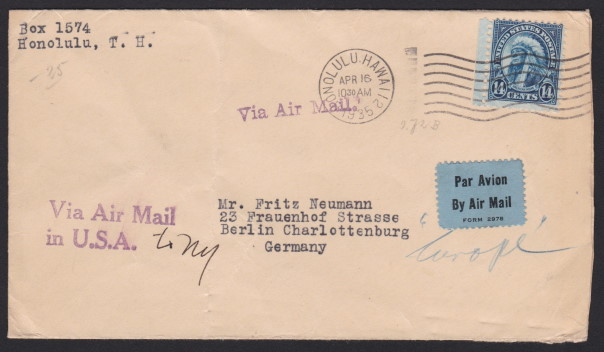By sea, by air, by sea, by air: a 14¢ American Indian solo usage
One of the most recent additions to my collection of 14¢ American Indian stamps on cover is a cover mailed from Hawaii to Germany in 1935. The envelope was postmarked in Honolulu on April 16, 1935, and dispatched from there to Berlin.
As I imagine you’re aware, examples of the 14¢ American Indian stamp used by itself are few and far between. 14¢ simply wasn’t a common postage rate during the time the stamp was in use, and it took me a bit of time to track down exactly why that particular rate applied in this case. I did, however, eventually find the answer in U.S. International Postal Rates, 1872–1996 by Harry Beecher and Anthony Wawrukiewicz.
Beginning in 1934, the rate for a one-ounce leetter by air within the continental United States plus surface transportation to international destinations was 8¢. That amount paid for surface transportation from Hawaii, which was still a territory at that time, to the mainland; airmail across the United States to New York City; and then surface transportation again from New York to Europe.
From there, a 3¢ per half ounce surcharge was in effect for letters carried by air from France to other points within Europe. Multiply that by two for a letter weighing between a half ounce and one ounce, and you get 6¢, the remaining amount of postage paid.
In summary, 8¢ postage paid for transportation by ship from Hawaii to the mainland United States, by airplane across the country, and by ship from New York to France, and 6¢ paid for transportation by airplane from France to Germany. This is really an exceptional usage of the stamp.
Published 2020-12-25

Comments
Log in or leave an anonymous comment.